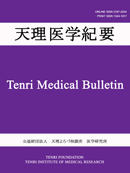Volume 16, Issue 2
Displaying 1-12 of 12 articles from this issue
- |<
- <
- 1
- >
- >|
Special Article
-
2013 Volume 16 Issue 2 Pages 59-69
Published: December 25, 2013
Released on J-STAGE: December 25, 2013
Download PDF (2374K)
Original Article
-
Article type: Original Article
2013 Volume 16 Issue 2 Pages 70-78
Published: 2013
Released on J-STAGE: December 25, 2013
Download PDF (475K)
Case Report
-
Article type: Case Report
2013 Volume 16 Issue 2 Pages 79-88
Published: December 25, 2013
Released on J-STAGE: December 25, 2013
Download PDF (5141K) -
Article type: Case Report
2013 Volume 16 Issue 2 Pages 89-100
Published: December 25, 2013
Released on J-STAGE: December 25, 2013
Download PDF (13510K) -
Article type: Case Report
2013 Volume 16 Issue 2 Pages 101-105
Published: December 25, 2013
Released on J-STAGE: December 25, 2013
Download PDF (2713K)
Mini-symposium for resident physicians of Tenri Hospital
-
Article type: Mini-symposium for resident physicians of Tenri Hospital
2013 Volume 16 Issue 2 Pages 106-110
Published: December 25, 2013
Released on J-STAGE: December 25, 2013
Download PDF (2054K) -
Article type: Mini-symposium for resident physicians of Tenri Hospital
2013 Volume 16 Issue 2 Pages 111-118
Published: December 25, 2013
Released on J-STAGE: December 25, 2013
Download PDF (6133K) -
Article type: Mini-symposium for resident physicians of Tenri Hospital
2013 Volume 16 Issue 2 Pages 119-125
Published: December 25, 2013
Released on J-STAGE: December 25, 2013
Download PDF (4022K)
Brief Report
-
Article type: Brief Report
2013 Volume 16 Issue 2 Pages 126-132
Published: December 25, 2013
Released on J-STAGE: December 25, 2013
Download PDF (656K)
Pictures at Bedside and Bench
-
Article type: Pictures at Bedside and Bench
2013 Volume 16 Issue 2 Pages 133-135
Published: December 25, 2013
Released on J-STAGE: December 25, 2013
Download PDF (5209K) -
Article type: Pictures at Bedside and Bench
2013 Volume 16 Issue 2 Pages 136-137
Published: December 25, 2013
Released on J-STAGE: December 25, 2013
Download PDF (2258K) -
Article type: Pictures at Bedside and Bench
2013 Volume 16 Issue 2 Pages 138-140
Published: December 25, 2013
Released on J-STAGE: December 25, 2013
Download PDF (1647K)
- |<
- <
- 1
- >
- >|
